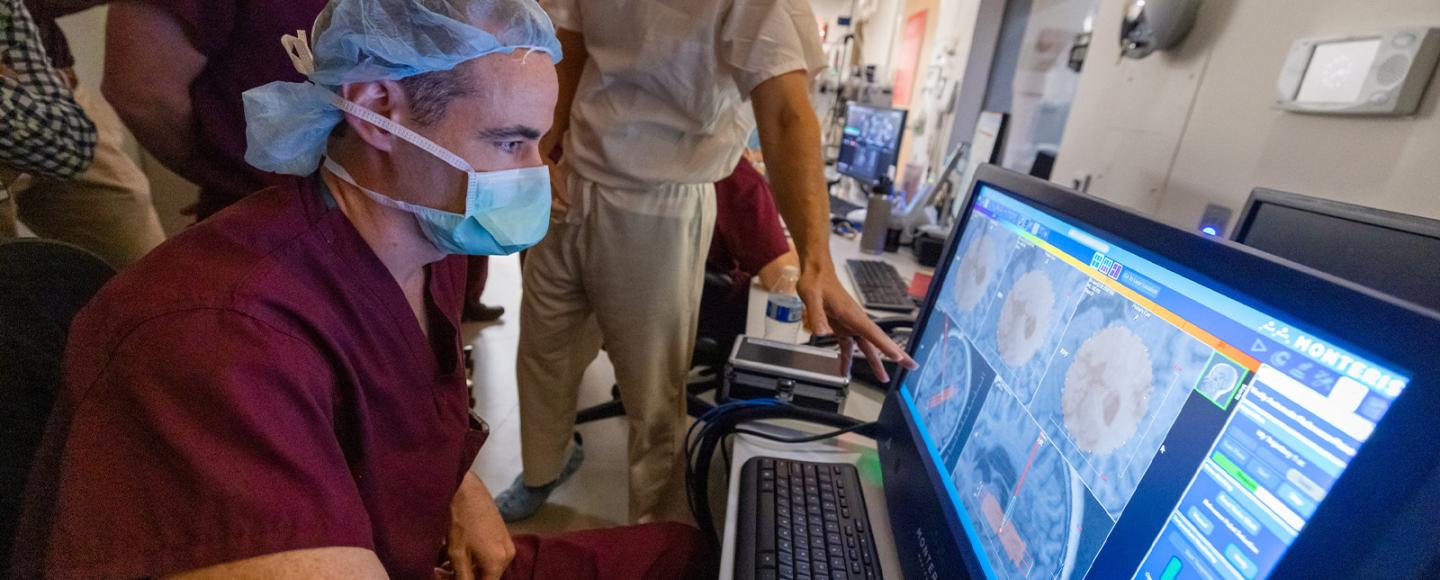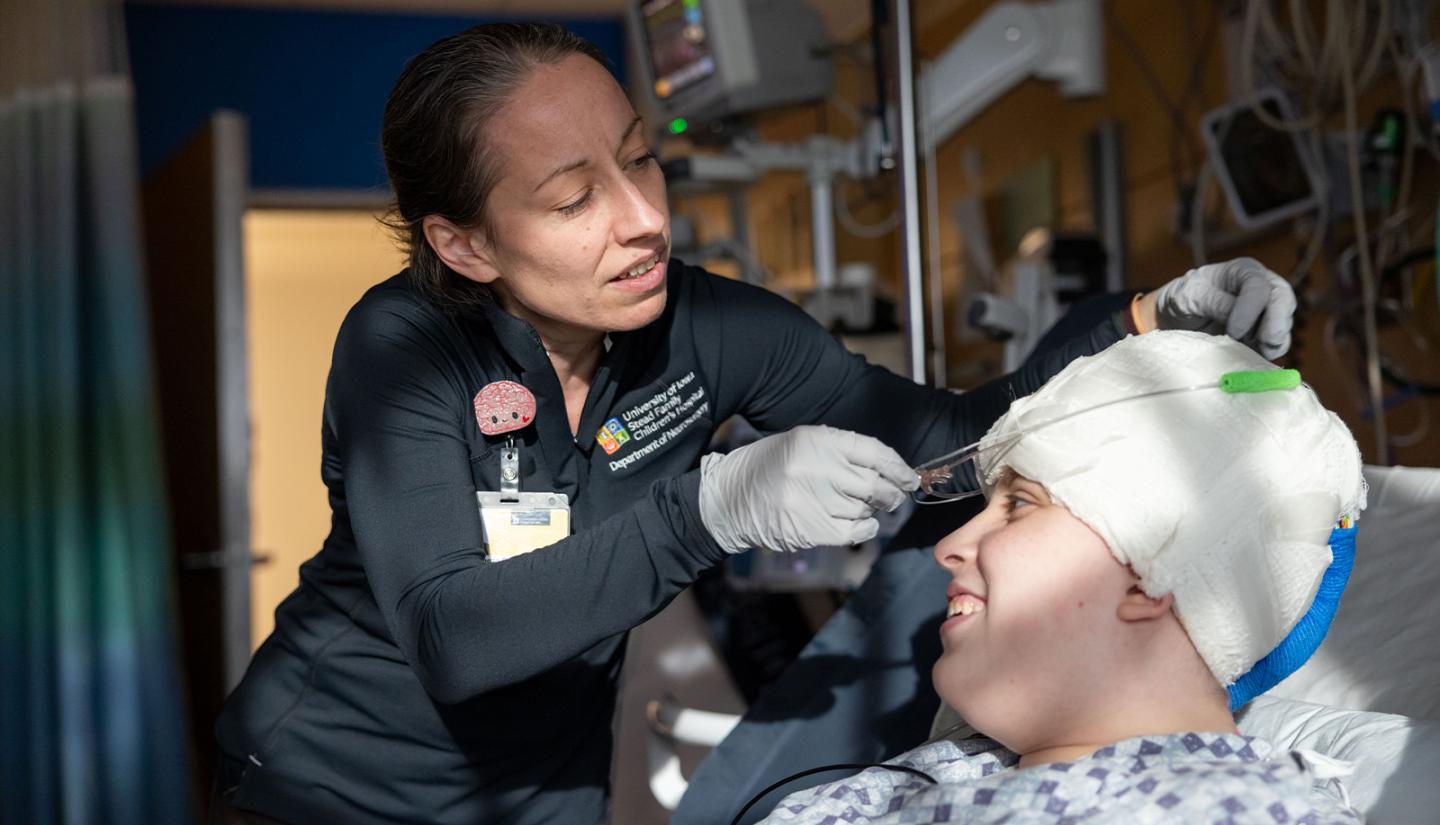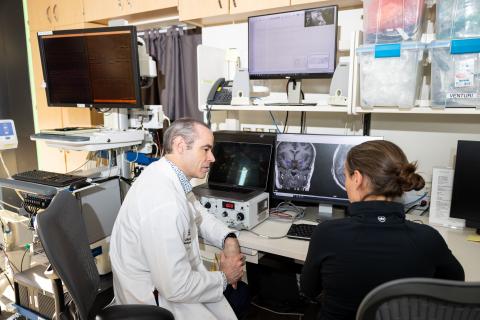Table of ContentsClose

Unraveling the SUDEP mystery
Iowa research pinpoints area in the brain’s amygdala as cause of sudden unexpected death in epilepsy
Tick, tick.
For people with epilepsy and their loved ones, sudden unexpected death in epilepsy (SUDEP) is “a ticking time bomb that creates anxiety and fear,” says University of Iowa neurosurgeon Brian Dlouhy, MD (13R, 14F).
As the name suggests, SUDEP happens when an otherwise healthy person with epilepsy dies suddenly and without a clear cause. It’s responsible for more than 3,000 deaths in the U.S. each year and is the leading cause of death in people with poorly controlled seizures.
“SUDEP is not that common, but it's likely underreported and thus much more common than people realize,” Dlouhy says.
The mechanisms that cause SUDEP have eluded the medical community for years, with researchers exploring a variety of different triggers. That is until October 2023, when Dlouhy and his research team published findings in JCI Insight that identified for the first time a specific site in the brain's amygdala that can cause prolonged apnea even after an epileptic seizure has ended.
Dlouhy, an associate professor in the Carver College of Medicine Department of Neurosurgery and the Stead Family Department of Pediatrics, is part of a UI research team that has devoted more than a decade to studying the causes behind SUDEP.
“We followed the data, and our research findings ultimately fell into place as nicely as they possibly could,” Dlouhy says. “It seems like this may be the answer to what causes SUDEP.”
1 in 1,000
Estimated annual SUDEP occurrence for people with epilepsy
1 in 150
Annual death rate from SUDEP for people with epilepsy whose seizures are poorly controlled with medication
Source: Epilepsy Foundation
Connecting on SUDEP research
Dlouhy came to Iowa in 2007 for residency training in neurosurgery, attracted by its reputation and commitment to neurosurgical research. SUDEP wasn't on his radar when he started working as a research fellow with John Wemmie (96MD, 96PhD, 00R), professor in the Department of Psychiatry and a co-author of the JCI Insight paper.
At the time, Dlouhy was interested in the connection between the amygdala and emotions. As part of his research in Wemmie's lab, he found that lesioning the amygdala in mice led to an exaggerated panic response to CO2 inhalation and increased breathing.
It was around this time that George Richerson (87MD, 87PhD) started work in the Department of Neurology. Richerson was internationally known for his research in breathing control and SUDEP.
"He brought this interest in SUDEP to the university," says Dlouhy.
Richerson, also a co-author on the amygdala paper in JCI Insight, notes that Dlouhy “started studying SUDEP pretty much independently of me, but because his research was related to what I do, it was natural for him to enlist my help.”
With the results of Dlouhy’s experiments in mice and the amygdala in mind, the group developed the hypothesis that the amygdala is involved in breathing control.
“Dlouhy was interested in testing the converse of what he did in mice to see what effect stimulating the human amygdala would have on anxiety, fear, and breathing,” says Wemmie.
Epilepsy patients who continue to have seizures despite anti-seizure medications may elect to undergo intracranial electroencephalography (iEEG), in which electrodes are implanted into their brain. The patients are monitored after electrode implantation for two weeks to identify the patient’s seizure focus, which can be surgically resected to stop their seizures. During this monitoring period, electrical stimulation mapping of the brain using the implanted electrodes determines what brain sites control speech, movement, sensation, and breathing.
“Dlouhy found that if he stimulated an area around the basolateral amygdala, patients would stop breathing. Remarkably, they were not aware that they had stopped breathing,” says Wemmie.
United research front
For years, dangerous heart rhythms or cardiac arrest were thought to be the primary causes of SUDEP. But the Iowa SUDEP research team was united in their hypothesis that, in most cases, blame lay with changes in breathing.
Research—at Iowa and outside the university—began to confirm the team's hypothesis. Most notably, a 2013 study documented SUDEP in epilepsy monitoring units around the world and found that patients who died from SUDEP had stopped breathing before their heart stopped. However, more data was needed to fully understand the mechanisms at work.
"We needed to know how a seizure travels from the cortex, which is where seizures occur, to the brain stem where breathing occurs, and what is different about some patients who die versus those who just have a seizure and recover," says Richerson.

A path toward SUDEP prevention
Collaboration was at the heart of the Iowa group’s most recent discovery. Dlouhy and the team worked with 20 patients with intractable epilepsy undergoing iEEG in preparation for epilepsy surgery. With electrodes in place, the researchers recorded activity and monitored breathing while stimulating the brain and mapped out brain sites associated with postictal, or post-seizure, apnea.
Earlier research had identified an area in the amygdala responsible for inhibiting breathing during seizure activity. This time, investigators were able to narrow that area down to a more specific site where apnea continued after the seizures had ended. This location was named the persistent amygdala inhibition of respiration (pAIR) site.
Five out of 20 patients experienced apnea during electrical stimulation, which persisted after the stimulation ended. In one patient, this apnea lasted for almost 13 minutes.
“They had irregular breathing after the seizure with prolonged periods of apnea that would last 20 to 30 seconds, and then they'd take a big breath and stop breathing again,” says Dlouhy. “Eventually, the patient returned to regular breathing.”
As in earlier studies, patients were unaware that they had stopped breathing and didn't experience any feelings of fear or anxiety related to the cessation. Previous research conducted by Iowa researchers on mice suggested that this is due to the effect of the amygdala on the brainstem's CO2 sensing system. Rising CO2 levels normally cause “air hunger,” making a sleeping person wake up or clear their airway if it's blocked by a pillow, for example.
The research team had an opportunity to investigate the role of CO2 and breathing in a patient with persistent apnea in the operating room.
“We took advantage of the precise respiratory measurements obtained by the clinically used breathing tube in the operating room, all while stimulating the amygdala,” says Dlouhy.
As they had done when awake, the patient exhibited persistent apnea with electrical stimulation of the amygdala. When the patient began breathing again, even though their CO2 level was elevated, the amount of air moving in and out of the patient’s lungs was smaller than normal. This continued for 10 to 15 minutes before returning to baseline. Stimulating the pAIR site not only inhibited respiration but also inhibited the CO2 drive to breathe.
The team also used a novel approach called electrical stimulation concurrent with functional MRI (es-fMRI) to study the amygdala during and after stimulation.
“The patient is in the MRI, and we're electrically stimulating their amygdala and looking at what's causing this inhibition of breathing,” Dlouhy says.
They discovered that the medulla and superior pons—areas in the brain where the respiratory network is located—demonstrated less activity when the pAIR site was stimulated. Activity in the ventral insula—a part of the brain involved in air hunger—was also changed by pAIR stimulation.
These findings bring the researchers one step closer to understanding SUDEP and developing measures to prevent it. Dlouhy is already looking to the future.
“We've done some experiments to see if we can inhibit that amygdala site to stop the seizures from causing a loss of breathing. That could be a potential neurosurgical preventative strategy for SUDEP and a possible clinical trial in the future,” he says. "These things mean a long road, and I don't want to give false hope, but that's the goal."
Team science

UI Health Care’s SUDEP program brings together a team of research scientists, students, and resident physicians with expertise in neurosurgery, neurology, psychiatry, pulmonary medicine, anesthesiology, and epilepsy.
“We've gone from a time in 2010 when no one at Iowa was really studying SUDEP to this research being a major part of our institution and being internationally known for our work on SUDEP,” says George Richerson, MD, PhD. “It's a great example of team science, where people with their own expertise are all focused on the same problem and try to come up with a way to prevent a terrible tragedy.”
The patients who volunteer to be a part of this research are also key members of the team. Without their participation and consent, none of this would be possible.
“The patients and families are all so incredibly giving of their time and willingness to want to participate in this research. And for that, I'm forever thankful,” says Brian Dlouhy, MD. “Ultimately, we hope that what these patients are doing will help them as well as patients in the future.”
Global search
UI Health Care is one of 14 institutions from the U.S. and Europe that have participated in an NIH-funded research consortium called the Center for SUDEP Research to uncover more about this mysterious condition. Find additional information about the consortium’s novel research at sudepresearch.org.
